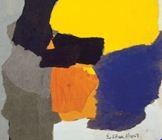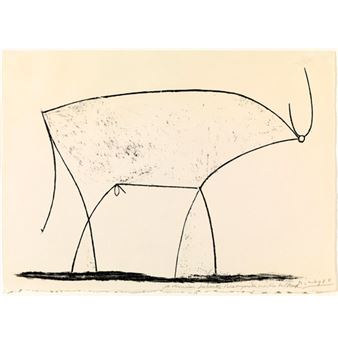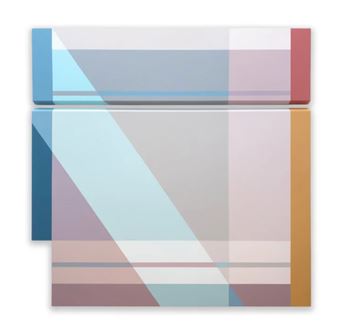Esteban Vicente: Concrete Improvisations: Collages and Sculpture
In New York, Vicente painted traditional portraits and landscapes until the early 1940s. He made a conscious decision at that point to stop showing his art for a period in order to understand the work of the Abstract Expressionists, with whom he began to associate. Finally, VicenteÔÇÖs breakthrough came when his work was selected by art critic Clement Greenberg and art historian Meyer Schapiro for inclusion in the Talent 1950 exhibition at the Samuel Kootz Gallery. Vicente continued to experiment with Abstract Expressionism for some 20 years and at one time shared a studio with Willem de Kooning.
Over the course of his career, Vicente also taught art at several universities, including the University of Puerto Rico, Black Mountain College, New York University, Yale University and the University of California at Berkeley. While teaching at these institutions, away from his New York studio, Vicente found himself unable to paint. It was while teaching at Berkeley in 1949 that he decided to begin experimenting with collage. Initially he used supplements from San Francisco newspapers. He then began painting handmade paper, which he would manipulate on a canvas surface. Vicente called his collages ÔÇ£paintings on paper,ÔÇØ and they became a fundamental part of his artistic focus.
Concrete Improvisations: Collages and Sculpture by Esteban Vicente will feature approximately 80 of the artistÔÇÖs works, both collages and polychrome sculptures, which Vicente referred to as divertimientos or juegos, (ÔÇ£toysÔÇØ in English). VicenteÔÇÖs ÔÇ£toysÔÇØ display his thorough understanding of Cubism, Constructivism and assemblage. Together, this group of works will reveal interesting facets of the career of this accomplished, if unassuming, artist.
This exhibition is curated by Dr. Lynn Gumpert, director of New York UniversityÔÇÖs Grey Art Gallery, Dr. Ana MartÎØnez de Aguilar, director of the Museo de Arte ContemporÎæneo Esteban Vicente, Segovia, and Dr. Edward J. Sullivan, the Helen Gould Sheppard Professor of the History of Art at NYU. It is the most important and largest monograph exhibition of VicenteÔÇÖs collages to date. The exhibition will be accompanied by a fully illustrated catalogue. Concrete Improvisations will be on view at the Meadows Museum from May 15-July 31, 2011, after its initial showing at NYUÔÇÖs Grey Art Gallery from January 11-March 26, 2011. Following the Meadows, the exhibition will make its third and final stop at the Museo de Arte ContemporÎæneo Esteban Vicente, Segovia. The Harriet and Esteban Vicente Foundation, the Whitney Museum of American Art and the Museo Nacional Centro de Arte Reina SofÎØa are among the institutions generously lending works to this exhibition.

Recommended for you
In New York, Vicente painted traditional portraits and landscapes until the early 1940s. He made a conscious decision at that point to stop showing his art for a period in order to understand the work of the Abstract Expressionists, with whom he began to associate. Finally, VicenteÔÇÖs breakthrough came when his work was selected by art critic Clement Greenberg and art historian Meyer Schapiro for inclusion in the Talent 1950 exhibition at the Samuel Kootz Gallery. Vicente continued to experiment with Abstract Expressionism for some 20 years and at one time shared a studio with Willem de Kooning.
Over the course of his career, Vicente also taught art at several universities, including the University of Puerto Rico, Black Mountain College, New York University, Yale University and the University of California at Berkeley. While teaching at these institutions, away from his New York studio, Vicente found himself unable to paint. It was while teaching at Berkeley in 1949 that he decided to begin experimenting with collage. Initially he used supplements from San Francisco newspapers. He then began painting handmade paper, which he would manipulate on a canvas surface. Vicente called his collages ÔÇ£paintings on paper,ÔÇØ and they became a fundamental part of his artistic focus.
Concrete Improvisations: Collages and Sculpture by Esteban Vicente will feature approximately 80 of the artistÔÇÖs works, both collages and polychrome sculptures, which Vicente referred to as divertimientos or juegos, (ÔÇ£toysÔÇØ in English). VicenteÔÇÖs ÔÇ£toysÔÇØ display his thorough understanding of Cubism, Constructivism and assemblage. Together, this group of works will reveal interesting facets of the career of this accomplished, if unassuming, artist.
This exhibition is curated by Dr. Lynn Gumpert, director of New York UniversityÔÇÖs Grey Art Gallery, Dr. Ana MartÎØnez de Aguilar, director of the Museo de Arte ContemporÎæneo Esteban Vicente, Segovia, and Dr. Edward J. Sullivan, the Helen Gould Sheppard Professor of the History of Art at NYU. It is the most important and largest monograph exhibition of VicenteÔÇÖs collages to date. The exhibition will be accompanied by a fully illustrated catalogue. Concrete Improvisations will be on view at the Meadows Museum from May 15-July 31, 2011, after its initial showing at NYUÔÇÖs Grey Art Gallery from January 11-March 26, 2011. Following the Meadows, the exhibition will make its third and final stop at the Museo de Arte ContemporÎæneo Esteban Vicente, Segovia. The Harriet and Esteban Vicente Foundation, the Whitney Museum of American Art and the Museo Nacional Centro de Arte Reina SofÎØa are among the institutions generously lending works to this exhibition.

 ARTISTS
ARTISTS
















